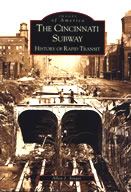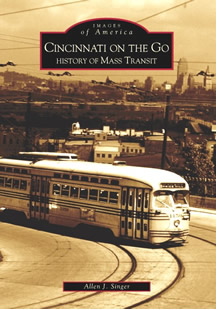Stepping Out in Cincinnati:
Queen City Entertainment 1900-1960
by Allen J. Singer
Stepping Out in Cincinnati is an overview of entertainment venues in the Queen City from 1900 to 1960. The book is packed with 210 mostly-vintage images and well-researched information about what made Cincinnati an entertainment showplace in the first half of the century.
A note on the images: nearly all of the photographs in Stepping Out came from private collectors. A large portion of movie theater photos came from the generous donation of www.cincinnatihistory.com. Photographer Ben Rosen took thousands of pictures from the 1930s to the 1970s, and cincinnatihistory is gradually making them available to the public. I ask you to please stop by their website if you are interested in viewing historical images from the Queen City.
Stepping Out in Cincinnati has seven exciting, informative chapters:
-
Movie theaters. Their locations, their stories, and the rise and fall of downtown movie-going. Prominently featured are the Lyric, the Capitol, the Albee, the Keith, and the Palace. The reader also experiences many of Cincinnati’s other theaters: the Family/Western, Heuck’s Opera House/Rialto, the Grand, the Shubert, the Cox, the Orpheum, the Times, the Strand, the Olympic, the Warsaw, the Western Plaza, the Empire, the Imperial, the Forest, the Ridge, the Bond, the Nordland, the 20 th Century, the Hippodrome, the Madison, the Delbee, and Newport’s Strand. This chapter alone is worth the price of admission.
- Prohibition era. The history and events of Prohibition and how it affected the great beer-town of Cincinnati. Also featured are the speakeasies: where many of them were located, how they worked, and what finally happened to them. Images include a cross-section of saloons around town, Prohibition political cartoons, and newspaper comics discussing the problems of obtaining alcohol and the dangers of bootleg whisky.
- Burlesque and vaudeville. A history of live variety performance and its affect on Cincinnati. The chapter includes discussions of the growth of the theater palace, events at the Gayety, and the impact of movies and television. Images include photos and postcards of variety houses, but the main attractions are the rare, unpublished photographs of vaudeville and burlesque acts taken inside the Shubert and other theaters around town. Also on display are scenes from the performance of Ziegfeld Follies from their 1934 show at the Shubert.
- Orchestras and Live Performance. This chapter examines the lives of the traveling vaudevillian and local musicians, as well as where all the best spots in town to experience live music and dancing. Images include the Cincinnati Symphony Orchestra, a minstrel show, 1920s and 1930s era dance bands, hotel orchestras, Moonlite Gardens, bands of the 1950s and early 1960s, and Topper Ballroom at Music Hall.
- Clubs and Casinos in Northern Kentucky. Gambling casinos in Newport, Kentucky is unheard of today, but a half-a-century ago, they were everywhere. This chapter gives the story of illegal gambling and its ultimate downfall in Newport. Exterior shots of some of the larger clubs are featured: Beverly Hills, the Lookout House, the Yorkshire, the Flamingo, and the Merchants Club. The reader will also see clandestine photos inside Beverly Hills, the Yorkshire, and the Glenn Rendezvous taken by photographers from the Saturday Evening Post in 1960.
- Black Entertainment Venues. Before the Civil Rights Movement of the 1950s, blacks did not mingle downtown with the whites. They were forbidden to enter nightclubs, dance halls, speakeasies, and even the big department stores. This chapter tells their story: what it was like for them to live next to white Cincinnati, where they went for fun during and after the Prohibition years, where they saw movies, and where they shopped for groceries. This chapter is an eye-opening experience for many white folks who could never know what it was like to be black in Cincinnati. Images include the Cotton Club, various black nightclubs, the Regal theater, and the Python Band.
- Radio and Television. A book on entertainment history requires a look at the electronic media of radio and TV. Radio and movies brought the end to live variety performance, and television killed the Golden Age of Radio and downtown movie-going. This chapter goes back to the earliest days of radio, looking at the evolution of WLW up to the development of television and station WLWT. Images include early WLW studios and orchestras, radio announcers Bill Edwards, Red Barber, Bill Nimmo, and Bill Myers as well as very early Rosemary and Betty Clooney. Television includes behind-the-scenes looks at WLWT in the early 1950s, Ruth Lyons, Bob Braun, Marian Spelman, Midwestern Hayride, Paul Dixon, and ends with the author’s visit to the Uncle Al Show in 1973.


